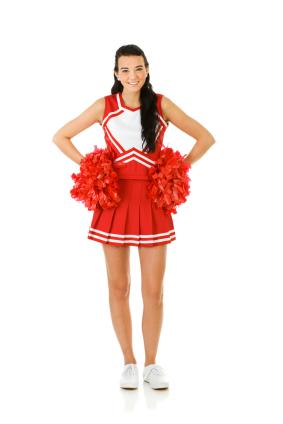
There are basic cheerleading motions that nearly all cheerleaders use, whether you cheer for your school squad or do competitive cheer. Knowing each motion can help you learn new routines quickly and easily. Performing the motion correctly helps the entire squad appear uniform and sharp during performances.
Basic Cheerleading Motions
There are a few motions that cheerleaders learn and use right from the beginning. Even when you advance to higher levels in your cheer career, you will still use these basic motions over and over again.
Ready Position

This is a basic starting position for almost every routine. Feet are shoulder width apart and both hands are in fists resting just where the hips begin. Elbows should be straight out to the sides and not pointed to the front.
Hand Clasp

Although it may appear that a cheerleader is clapping, more than likely she is clasping her hands together. This creates a sharp look to the routine and is more dramatic when the cheerleader is trying to get the audience to clap with her.
T Motion

Arms are straight out to the sides at shoulder height and hands should be turned so that the thumbs face forward and the pinky fingers face to the back. Hands are in tight fists. Feet are typically together, but this can vary by routine.
Broken T

To create a broken T motion, raise both arms so that your fists rest on your chest at shoulder height. The thumb should be to the back, closest to your body and the pinky finger toward the front, facing out. Be careful to keep your elbows raised and not drop them. Keep your fists close to your body for a tight, sharp movement.
Intermediate Motions for Cheerleaders
Touchdown

To perform a touchdown motion, straighten your arms and bring them up on either side of your ears. Hands are in a fist with the pinky finger forward. Feet are together. There is also a motion called the low touchdown. To perform a low touchdown, straighten your arms and bring them straight down so they are on either side of the thighs. The thumbs point forward in the low touchdown.
V Motion

The V motion can be done as a high V or low V. Start with legs shoulder width apart. To complete a high V motion, the arms are straight up but out from the head by about 45 degrees. Make the arms about the same width apart as the legs and you'll be very close to a perfect high V. Thumbs face forward. To do a low V, reverse the motion and bring arms out about 45 degrees from the legs.
Right and Left Punch

This move may seem simple, but the alternating motion of one hand on the hip and the other hand punching up can be confusing for very young or new cheerleaders. However, if you stick with cheerleading, you will learn this motion fairly early on in your cheer career. To perform a right punch, as shown above, place your left hand on your hip with your elbow straight out to your side. The right arm should be straight up beside your ear. To perform a left punch, reverse the motion and put your right hand on your hip and your left arm straight up in the air.
Advanced Moves
L Motion

Imagine that your arms are creating a straight letter "L" and you should be able to complete this cheer motion. Although the cheerleader above has the right idea with her right arm straight to the side and her left arm up, she needs to move her arms into better position to be an advanced cheerleader. To perform a right L, place your right arm straight out to the side at shoulder height (the cheerleader above needs to raise her arm a bit). The thumb should face forward. The left arm is straight up next to the ear (the cheerleader above needs to straighten her left arm and bring it closer to her head). To perform a left L, simply reverse the motions and put the left arm out straight to the side and the right arm straight up next to your head.
Right and Left K
The K is an advanced cheerleading motion that takes a lot of practice and coordination to perform correctly, especially in the middle of a routine when you are trying to remember multiple moves. To perform a right K, the right leg is to the side in a partial lunge and the left leg faces forward with your toes pointed to the front as well. The right arm goes straight up and into a 45 degree position away from the head. Remember, if your feet are shoulder width apart, then your arm will match the width about where the outside of your right foot is. The left arm is lowered and comes across your chest and to the right side. To perform a left K, place the left arm up and the right arm across the body.
Putting it All Together
Practice each cheerleading motion until you can perform it without much thought. Keep your moves sharp and snappy. Once you've perfected the positions, begin to create drills where you move from a ready position to a high V to a low V. Go on to move from a right K to a left K to an L motion. With practice, you'll soon find that these moves are almost second nature.







